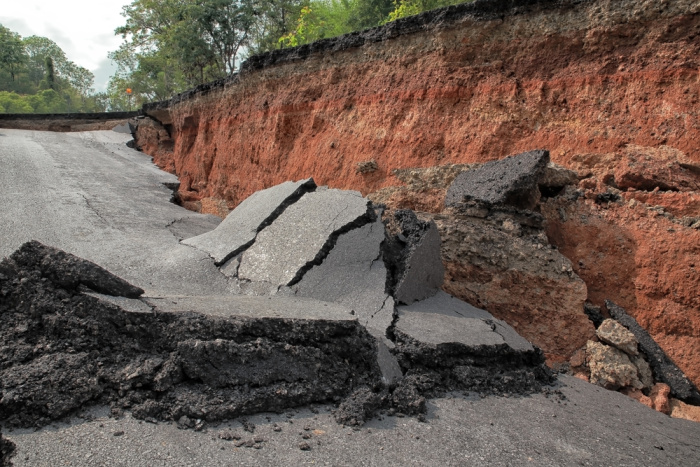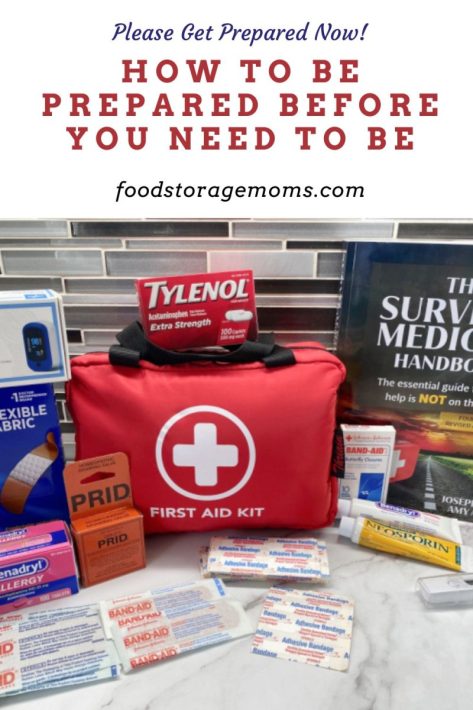
We never know when life will throw us a curveball, such as a natural disaster, power outage, food shortage, or medical emergency. Preparedness isn’t about fear; it’s about peace of mind. Being prepared before you need to be means you’ll have the essentials when everyone else is scrambling.
I have been prepared for just about any unforeseen disaster scenario for most of my adult life. During the COVID-19 pandemic, I managed to survive without needing to go to the store every week. Part of why I started my blog was to help you be prepared before you need to be.
When you are prepared, you don’t have to stress or be worried when something happens. Today, I am going to share some great ways to get started with being prepared!
Be Prepared Before You Need to Be
Life happens, and we don’t always know what is going to happen. The key to being prepared is thinking ahead. Here are some ways to start doing that!

What Could Happen?
The first step is to consider why you need to be prepared. Each person will need to prepare differently, depending on their circumstances, location, and potential local risks.
For example, I prepare for several situations that could happen, which include: fires, flooding, earthquakes (I live in an area where they are frequent), and pandemics. Maybe you have wildfires, earthquakes, or blizzards where you live.
Please consider the potential events in your area, and visit my blog for help preparing for various scenarios. Here are a few good posts you may want to check out:
- How Can You Be Prepared for a Tornado
- Things to Stock Up On Before a Hurricane
- How to Emergency Prep for a Winter Storm
- When the Power Grid Fails: Things You Will Need
Start Preparing!
Once you have figured out what you need to prepare for, start doing it! No matter what natural disaster or unforeseen scenario could happen, you will need some necessities, such as food and water. If you haven’t started prepping, I would encourage you to read my post “Prepping For Beginners: A Guide to Get You Started.”
Be Prepared with a Garden
Another great way to be prepared for the inevitable is to be self-sufficient. Right now, you can buy things all day long at the store, and you can have a year’s worth of food and water saved up, but what happens if you can no longer go to the store? You have to know how to grow at least some of your own food.
Start learning how to get that Green Thumb! If you haven’t grown your own food before, I would suggest reading “The 8 Easiest Vegetables to Grow for Beginners.”
Be Prepared With Water Sources
The truth is, we can stock up on water and store enough for several months or longer, but if we can’t purchase more, we need to know how to obtain it on our own. If you are starting, read “How to Store Water for Drinking and Cooking.” In addition to storing water, it’s essential to know how to locate water sources and purify water for drinking. To be prepared before you need to be, I suggest reading the following posts:
- How to Make Water Safe in an Emergency
- How to Find Other Water Sources in an Emergency
- Emergency Water Storage: How to Store It
Water
- Why it’s critical: You can only survive about 3 days without water.
- What to store:
- 1 gallon per person per day (minimum). I prefer 4 gallons per person per day.
- Water filters (LifeStraw, Berkey, Sawyer Mini).
- Water purification tablets or unscented bleach.
- Collapsible water containers or 55-gallon barrels.
Food
- Why it’s critical: Keeps energy and morale up during crises.
- What to store:
- Canned goods (vegetables, meats, beans, soups).
- Freeze-dried or dehydrated meals.
- Grains (rice, oats, pasta) and dry beans.
- Peanut butter, honey, and powdered milk.
- Manual can opener.
Shelter and Warmth
- Why it’s critical: Exposure to cold or heat can be deadly within hours.
- What to have:
- Emergency blankets or sleeping bags.
- Tent or tarp with paracord.
- Extra clothing and sturdy shoes.
- Hand warmers, gloves, and thermal layers.
Fire and Heat Source
- Why it’s critical: Needed for warmth, cooking, and sterilization.
- What to store:
- Waterproof matches, lighters, or ferro rods.
- Small stove (propane, butane, or wood).
- Fuel (stored safely).
- Candles and lanterns.
First Aid and Medicine
- Why it’s critical: Medical help may not be available.
- What to include:
- A fully stocked first aid kit.
- Prescription medications (rotate regularly).
- Pain relievers, bandages, and antiseptic wipes.
- Tweezers, scissors, gloves, and gauze.
- Emergency medical guidebook.
Light Sources
- Why it’s critical: Power outages make navigation and safety difficult.
- What to keep:
- LED flashlights and headlamps.
- Extra batteries or rechargeable solar lights.
- Glow sticks for quick light.
Communication Tools
- Why it’s critical: To receive updates or call for help.
- What to have:
- Battery-powered or crank emergency radio (NOAA).
- Whistle or signal mirror.
- Fully charged power banks and solar chargers.
Personal Hygiene and Sanitation
- Why it’s critical: Prevents illness and maintains comfort.
- What to store:
- Soap, toothpaste, toilet paper, baby wipes.
- Trash bags, a bucket with a lid for an emergency toilet.
- Hand sanitizer and feminine products.
Tools and Multi-Use Gear
- Why it’s critical: Useful for repairs, protection, and survival tasks.
- What to include:
- Multi-tool or Swiss Army knife.
- Duct tape, rope, tarp, and plastic sheeting.
- Small shovel or hatchet.
Important Documents and Cash
- Why it’s critical: Needed for identification, insurance, and transactions.
- What to store:
- IDs, passports, insurance papers, deeds.
- Emergency contact list.
- Small bills and coins in a waterproof bag.
Don’t Forget to Stock Other Essentials
Food and water are the essentials you should stock first! You can’t live without food and water. However, you also want to be prepared with other things you may not think about. Here is a list of different items I would recommend having a stockpile of for any disaster scenario:
- Personal Hygiene Items: This includes toothbrushes, toothpaste, shampoo, conditioner, soap, and for women, pads or tampons. Adult Wet Wipes
- Cleaning and sanitizing supplies: Bleach is number 1! Not only can you clean anything with bleach, but it can also be used to purify your water for drinking.
- First Aid Kit: Without access to a doctor, you’ll need supplies to stop bleeding, including some surgical supplies.
- OTC Medications: You probably aren’t a chemist and wouldn’t know how to create these medications. So, it is essential to stock up on medicines like Benadryl, fever reducers, and cold and flu medications.
- Paper products: If you can’t wash dishes, you will want disposable items that can be burned or thrown away. Things like paper plates, plastic utensils, and cups are good to have on hand.
- Toilet Paper: We all know how quickly stores can run out of toilet paper. That is often the first thing to go in an emergency. So, stock up now when it’s available! Also, learn to make reusable toilet paper.
Think about Bartering and Trading
This year, we have seen a coin shortage, which tells me we may be trending towards a cashless society. I always keep cash hidden and out of the bank for any scenario, but that doesn’t mean it will be useless at some point.
Therefore, it is always a good idea to consider bartering or trading to obtain what you need without cash. Please keep some money hidden in case you can’t withdraw it from the bank. But also, know how to barter and trade. Here are some posts to get you thinking:
- How to Survive in a Cashless Society
- 10 Ways to Save Money Using Cash
- How to Barter with Food and Water
- Top 50 Items You Need to Have to Barter
How to Be Prepared Before You Need to Be
1. Start with the Basics
- Water: Store at least one gallon per person per day for two weeks.
- Food: Build a 30-day supply of shelf-stable foods your family actually eats.
- Shelter: Keep blankets, a tent, and other ways to stay warm in case of a power outage.
2. Build Your Emergency Kits
- Home Kit: First aid, flashlights, batteries, cash, hygiene items.
- Car Kit: Jumper cables, food bars, extra clothes, and a phone charger.
- Go-Bag: Keep one ready for evacuation, including copies of important documents.
3. Learn Essential Skills
- Basic first aid and CPR
- How to cook without power
- How to filter or purify water
- Communication plans for your family
4. Get Your Home Ready
- Have fire extinguishers and know how to use them
- Store fuel safely
- Have backup lighting (solar lanterns, candles, flashlights)
- Know where to shut off water, gas, and power
5. Financial and Digital Preparedness
- Keep small bills on hand
- Back up important files to the cloud and a physical drive
- Have copies of IDs and insurance in a waterproof folder
6. Practice and Rotate
Preparedness isn’t a one-time task. Rotate your food, water, and fuel. Test your gear. Update your plan each year.
1: What does “being prepared before you need to be” mean?
It means taking proactive steps to ensure your family’s safety, comfort, and survival before an emergency happens.
2: How can I start prepping on a budget?
Begin with water, shelf-stable foods, and basic first aid supplies. Buy one or two extra items per grocery trip.
3: How often should I rotate my food storage?
Check and rotate food every 6–12 months, especially canned and dry goods.
4: What are the most critical preparedness items?
Water, food, light sources, first aid, and a reliable means of cooking or heating.
5: Why is preparedness important?
Emergencies rarely give warning. Being ready ensures your family’s safety and reduces panic and stress when disaster strikes.
Final Word
When it comes to being prepared, we may not think of everything, but the more we prep, the better we will be in any situation. Being prepared isn’t just about preparing for a significant disaster or collapse; it’s about being prepared even for conditions that can come our way, such as a job loss, personal health issues, the death of a loved one, etc. Remember, luck favors the prepared. May God bless this world, Linda
Copyright Images: Beneath the Asphalt Deposit photos_49226117_s-2019
The post How to Be Prepared Before You Need to Be appeared first on Food Storage Moms.
from Food Storage Moms
No comments:
Post a Comment